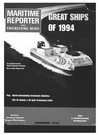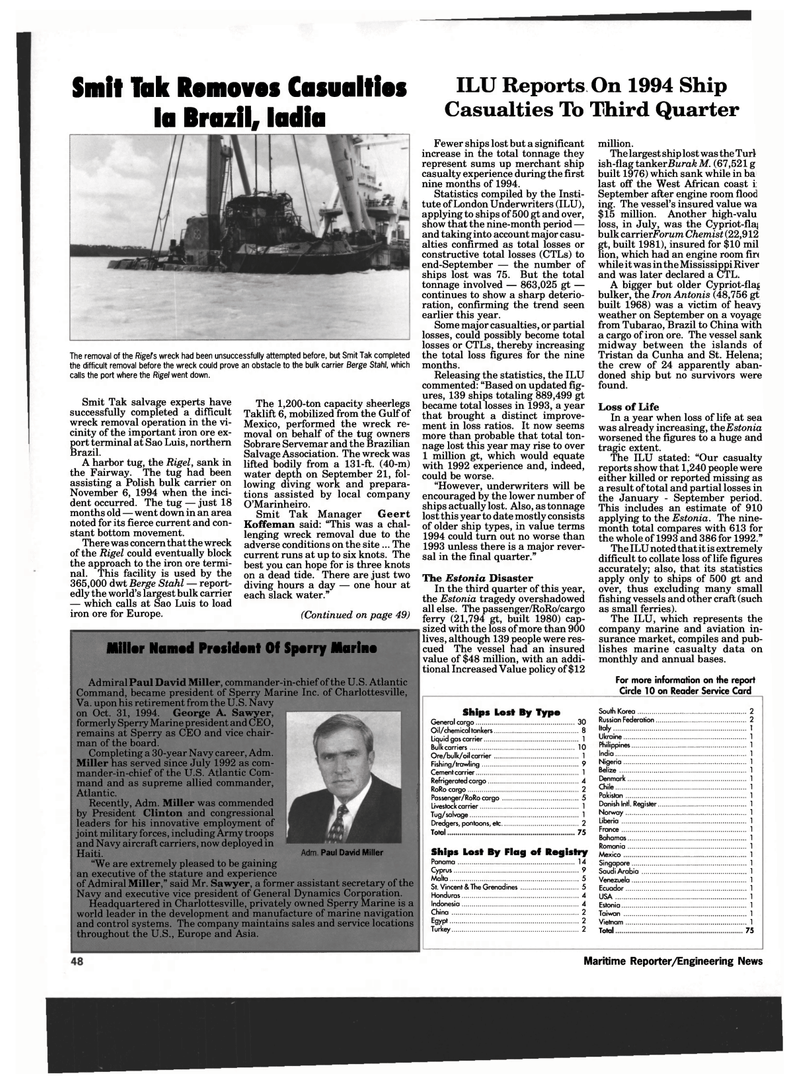
Page 48: of Maritime Reporter Magazine (December 1994)
Read this page in Pdf, Flash or Html5 edition of December 1994 Maritime Reporter Magazine
ILU Reports On 1994 Ship
Casualties To Third Quarter Smit Tak Removes Casualties la Brazil, ladia
The removal of the R/gefs wreck had been unsuccessfully attempted before, but Smit Tak completed the difficult removal before the wreck could prove an obstacle to the bulk carrier Berge Stahl, which calls the port where the Rigel went down.
Smit Tak salvage experts have successfully completed a difficult wreck removal operation in the vi- cinity of the important iron ore ex- port terminal at Sao Luis, northern
Brazil.
A harbor tug, the Rigel, sank in the Fairway. The tug had been assisting a Polish bulk carrier on
November 6, 1994 when the inci- dent occurred. The tug — just 18 months old — went down in an area noted for its fierce current and con- stant bottom movement.
There was concern that the wreck of the Rigel could eventually block the approach to the iron ore termi- nal. This facility is used by the 365,000 dwt Berge Stahl — report- edly the world's largest bulk carrier — which calls at Sao Luis to load iron ore for Europe.
The 1,200-ton capacity sheerlegs
Taklift 6, mobilized from the Gulf of
Mexico, performed the wreck re- moval on behalf of the tug owners
Sobrare Servemar and the Brazilian
Salvage Association. The wreck was lifted bodily from a 131-ft. (40-m) water depth on September 21, fol- lowing diving work and prepara- tions assisted by local company
O'Marinheiro.
Smit Tak Manager Geert
Koffeman said: "This was a chal- lenging wreck removal due to the adverse conditions on the site... The current runs at up to six knots. The best you can hope for is three knots on a dead tide. There are just two diving hours a day — one hour at each slack water." (Continued on page 49)
Fewer ships lost but a significant increase in the total tonnage they represent sums up merchant ship casualty experience during the first nine months of 1994.
Statistics compiled by the Insti- tute of London Underwriters (ILU), applying to ships of500 gt and over, show that the nine-month period — and taking into account major casu- alties confirmed as total losses or constructive total losses (CTLs) to end-September — the number of ships lost was 75. But the total tonnage involved — 863,025 gt — continues to show a sharp deterio- ration, confirming the trend seen earlier this year.
Some major casualties, or partial losses, could possibly become total losses or CTLs, thereby increasing the total loss figures for the nine months.
Releasing the statistics, the ILU commented: "Based on updated fig- ures, 139 ships totaling 889,499 gt became total losses in 1993, a year that brought a distinct improve- ment in loss ratios. It now seems more than probable that total ton- nage lost this year may rise to over 1 million gt, which would equate with 1992 experience and, indeed, could be worse. "However, underwriters will be encouraged by the lower number of ships actually lost. Also, as tonnage lost this year to date mostly consists of older ship types, in value terms 1994 could turn out no worse than 1993 unless there is a major rever- sal in the final quarter."
The Estonia Disaster
In the third quarter of this year, the Estonia tragedy overshadowed all else. The passenger/RoRo/cargo ferry (21,794 gt, built 1980) cap- sized with the loss of more than 900 lives, although 139 people were res- cued The vessel had an insured value of $48 million, with an addi- tional Increased Value policy of $12
Ships Lost By Type
General cargo 30
Oil/chemical tankers 8
Liquid gas carrier 1
Bulk carriers 10
Ore/bulk/oil carrier
Fishing/trawling 9
Cement carrier 1
Refrigerated cargo 4
RoRo cargo 2
Passenger/RoRo cargo 5
Livestock carrier 1
Tug/salvage
Dredgers, pontoons, etc 2
Total 75
Ships Lost By Flag off Registry
Panama 14
Cyprus 9
Malta 5
St. Vincent & The Grenadines 5
Honduras 4
Indonesia
China 2
Egypt
Turkey million.
The largest ship lost was the Turl ish-flag tankerBurak M. (67,521 g built 1976) which sank while in ba last off the West African coast i:
September after engine room flood ing. The vessel's insured value wa $15 million. Another high-valu loss, in July, was the Cypriot-flaj bulk carrierForum Chemist (22,912 gt, built 1981), insured for $10 mil lion, which had an engine room fir< while it was in the Mississippi River and was later declared a CTL.
A bigger but older Cypriot-flag bulker, the Iron Antonis (48,756 gt built 1968) was a victim of heavj weather on September on a voyage from Tubarao, Brazil to China with a cargo of iron ore. The vessel sank midway between the islands of
Tristan da Cunha and St. Helena; the crew of 24 apparently aban- doned ship but no survivors were found.
Loss of Life
In a year when loss of life at sea was already increasing, the Estonia worsened the figures to a huge and tragic extent.
The ILU stated: "Our casualty reports show that 1,240 people were either killed or reported missing as a result of total and partial losses in the January - September period.
This includes an estimate of 910 applying to the Estonia. The nine- month total compares with 613 for the whole of 1993 and 386 for 1992."
The ILU noted that it is extremely difficult to collate loss of life figures accurately; also, that its statistics apply only to ships of 500 gt and over, thus excluding many small fishing vessels and other craft (such as small ferries).
The ILU, which represents the company marine and aviation in- surance market, compiles and pub- lishes marine casualty data on monthly and annual bases.
For more information on the report
Circle 10 on Reader Service Card
South Korea 2
Russian Federation
Italy 1
Ukraine
Philippines
India
Nigeria 1
Belize
Denmark
Chile
Pakistan 1
Danish Intl. Register 1
Norway
Liberia
France 1
Bahamas
Romania
Mexico
Singapore 1
Saudi Arabia
Venezuela
Ecuador
USA 1
Estonia
Taiwan
Vietnam
Total 75
Miller Named President Of Sperry Marine
Admiral Paul David Miller, commander-in-chief of the U.S. Atlantic
Command, became president of Sperry Marine Inc. of Charlottesville,
Va. upon his retirement from the U.S. Navy on Oct. 31, 1994. George A. Sawyer, formerly Sperry Marine president and CEO, remains at Sperry as CEO and vice chair- man of the board.
Completing a 30-year Navy career, Adm.
Miller has served since July 1992 as com- mander-in-chief of the U.S. Atlantic Com- mand and as supreme allied commander,
Atlantic.
Recently, Adm. Miller was commended by President Clinton and congressional leaders for his innovative employment of joint military forces, including Army troops and Navy aircraft carriers, now deployed in
Haiti. "We are extremely pleased to be gaining an executive of the stature and experience of Admiral Miller," said Mr. Sawyer, a former assistant secretary of the
Navy and executive vice president of General Dynamics Corporation.
Headquartered in Charlottesville, privately owned Sperry Marine is a world leader in the development and manufacture of marine navigation and control systems. The company maintains sales and service locations throughout the U.S., Europe and Asia.
Adm. Paul David Miller 26D Maritime Reporter/Engineering News

 47
47

 49
49
